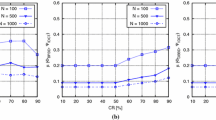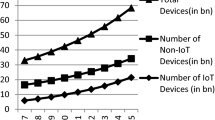Abstract
In this paper, we investigate the energy cost of the FPGA implementation of two cryptographic algorithms targeted to wireless sensor networks (WSNs). Recent trends have seen the emergence of WSNs using sensor nodes based on reconfigurable hardware, such as a field-programmable gate arrays (FPGAs), thereby providing flexible functionality with higher performance than classical microcontroller based sensor nodes. In our study, we investigate the hardware implementation of involutional block ciphers since the characteristics of involution enables performing encryption and decryption using the same circuit. This characteristic is particularly appropriate for a wireless sensor node which requires the function of both encryption and decryption. Further, in order to consider the suitability of a cipher for application to a wireless sensor node, which is an energy constrained device, it is most critical to consider the cost of encryption in terms of energy consumption. Hence, we choose two involutional block ciphers, KHAZAD and BSPN, and analyze their energy efficiency for FPGA implementation.











Similar content being viewed by others
References
Zhang X, Heys HM, and Li C (2011) “FPGA Implementation of two involutional block ciphers targeted to wireless sensor networks (Invited),” in Proc. of the 2011 International Conference on Communications and Networking in China (Chinacom’11), Harbin, China
Majeed J (2005) “FPGA based communication security for wireless sensor networks,” in Proc. of the 4th international Conference on Electronic, Signal Processing and Control (WSEAS’05), Rio de Janeiro, Brazil
Muralidhar P, and Rama Rao C (2008) “Reconfigurable wireless sensor network node based on NIOS core,” in Proc. of 4th Wireless Communication and Sensor Networks (WCSN’08), pp. 67–72
Peter S, Stecklina O, Portilla J, Torre E, Langendoerfer P, and Riesgo T (2009) “Reconfiguring crypto hardware accelerators on wireless sensor nodes,” in Proc. of the 6th Sensor, Mesh and Ad Hoc Communications and Networks Workshops, (SECON’09 Workshops), Rome, Italy
Krasteva YE, Portilla J, Carnicer JM, Torre E, and Riesgo T (2008) “Remote HW-SW reconfigurable wireless sensor nodes,” in Proc. of the 34th Annual Industrial Electronics (IECON’08), pp. 2483 – 2488, Orlando, FL
Mihel J, Magjarevic R (2009) “FPGA based two-channel ECG sensor node for wearable applications”, in Proc. of the 4th European Conference of the International Federation for Medical and Biological Engineering (IFMBE). Springer Berlin Heidelberg 22:1208–1211
Hinkelmann H, Zipf P, and Glesner M (2006) “Design concepts for a dynamically reconfigurable wireless sensor node,” in Proc. of the 1st NASA/ESA Conference on Adaptive Hardware and Systems (AHS‘06), pp. 436–441
Susu E, Magno M, Acquaviva A, and Atienza D (2007) “Reconfiguration strategies for environmentally powered devices: theoretical analysis and experimental validation,” Transactions on High-Performance Embedded Architectures and Compilers I (HiPEAC I), pp. 341–360
Portilla J, de Castro A, de la Torre E, Riesgo T (2006) A modular architecture for nodes in wireless sensor networks. Journal of Universal Computer Science (JUCS) 12(3):328–339
Belhadj H, Aggrawal V, Pradhan A, and Zerrouki A. “Power-Aware FPGA Design,” [online]. Available at: http://www.actel.com/documents/Power_Aware_WP.pdf
Barreto PSLM, and Rijmen V. “The KHAZAD Legacy-Level Block Cipher,” [online]. Available at: http://www.larc.usp.br/~pbarreto/KhazadPage.html
Youssef A, Tavares SE, and Heys HM (1996) “A new class of substitution-permutation networks”, in Proc. of Workshop on Selected Areas in Cryptography (SAC ’96), Queen’s University, Kingston, Ontario
Zhang X, Heys HM, and Li C (2010) “Energy efficiency of symmetric key cryptographic algorithms in wireless sensor networks,” in Proc. of 25th Biennial Symposium on Communications (QBSC’10), Kingston, Ontario
Daemen J, Rijmen V (2002) The design of Rijndael: AES - the Advanced Encryption Standard. Springer, New York
Zhang X (2010) Energy efficiency in secure wireless networks. M.Eng, Thesis, Memorial University of Newfoundland
Xilinx website: www.xilinx.com
“XPower Tutorial FPGA Design”, [online]. Available at: ftp.xilinx.com/pub/documentation/…tutorials/xpowerfpgatutorial.pdf
Author information
Authors and Affiliations
Corresponding author
Additional information
This work is supported in part by the funds from the Natural Sciences and Engineering Research Council (NSERC) of Canada.
This work is extended from its original version published at CHINACOM'11, Harbin, China, August 2011 [1].
Rights and permissions
About this article
Cite this article
Zhang, X., Heys, H.M. & Li, C. FPGA Implementation and Energy Cost Analysis of Two Light-Weight Involutional Block Ciphers Targeted to Wireless Sensor Networks. Mobile Netw Appl 18, 222–234 (2013). https://doi.org/10.1007/s11036-012-0353-7
Published:
Issue Date:
DOI: https://doi.org/10.1007/s11036-012-0353-7




